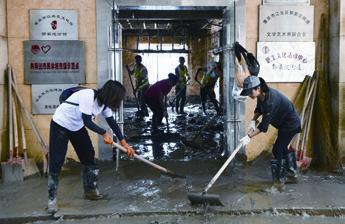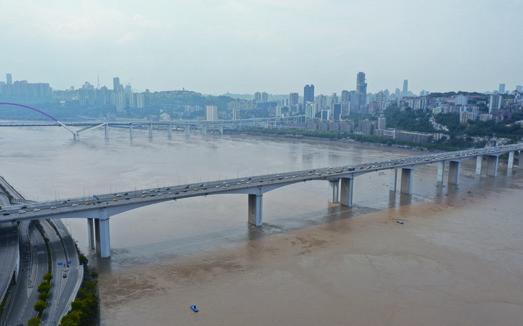Fighting Floods
By Ji Jing
With over 2,000 years of history, the Hongya Cave, an ancient fortress in Chongqing, southwest China, is a mustsee for visitors to the city. Its attraction as a tourist destination has been enhanced with an 11-storied stilt house built to accommodate a variety of cafes, bars and restaurants.


On August 22, the popular site was unrecognizable in a video posted on YouTube, which showed the once brightly lit complex completely dark and surrounded by muddy water.
Just four days earlier, the authorities had raised the flood-control response level in the metropolis to Level I, the highest in a four-tier emergency response system for fl oods, following heavy downpours on the upper reaches of the Yangtze River and neighboring Sichuan Province.
A watery year
China has seen more rainfall this year than usual. The national average precipitation reached 110.9 mm in June and 125.7 mm in July, 12 percent and 4 percent more respectively than in the same period in a normal year.
Wang Shiping, an expert with the Chongqing Emergency Management Bureau, told Cqnews.net that although there was no heavy rainfall in Chongqing, Sichuan had been flooded by the Yangtze and its tributaries and the water continued to spill over into Chongqing, which is at the confl uence of many rivers.
Chongqings main urban area is located at the intersection of the Jialing River and the Yangtze, two major rivers that are a focus of flood control. The Yangtze especially suffered several floods on its upper reaches in quick succession this rainy season, which aggravated the situation in Chongqing. On the morning of August 20, the most recent fl oodwaters of the Yangtze swirled through the main urban area of Chongqing.
It was the fifth flood the city suffered this year and apprehended to be the worst since 1981. According to the figures announced at a press conference held by the Chongqing Municipal Government Information Office on August 20, over 130,000 people had to be evacuated while the flood submerged thousands of stores, 320 roads, 148 bridges and over 8,600 hectares of farmland.
Around 28,000 emergency relief personnel were pressed into service and there were images of them carrying the elderly and children to safety on their back amid waist-high water.
Mitigation measures
Advanced warning was an important measure to keep the casualties as low as possible. Song Gangyong, director of the hydrology and fl ood and drought prevention department of the water resources bureau, said his department issued an alert more than 30 hours before the fl ood so that people living along the rivers had more time to evacuate.

A restaurant owner in Qijiang District said due to the advanced warning earlier as well, his family had managed to take shelter on higher grounds in June, when the fi rst fl oor of his twostoried establishment was submerged.
The water resources bureau also asked the hydropower stations in the city to discharge water from their reservoirs so that there would be greater capacity to store the floodwaters. The Hechuan Caojie Hydropower Station on the Jialing opened all its 21 gates to release the water in its reservoir. The Yinpan Hydropower Station on the Wujiang River also followed suit.
“If the hydropower stations hadnt discharged the water in their reservoirs, 100,000 more people would have needed to be evacuated,” Song said.
The local government allocated 19.8 million yuan ($2.9 million) for disaster relief while the evacuated people were accommodated in tents and schools and provided with food, clothes, water and medical treatment.
The Ministry of Finance and Ministry of Emergency Management announced on August 18 a funding of 460 million yuan($66.6 million) to four provincial-level regions, including Sichuan and Chongqing, as part of the disaster relief effort. The money is meant for emergency rescue and postdisaster rehabilitation.
Premier Li Keqiang arrived in Chongqing on August 20 to learn about the losses and boost peoples morale.
The village of Shuangba, which supplies vegetables to the main urban area of Chongqing, was one of the worst affected. The flood inundated 8 square km of the vegetable base and damaged almost all the greenhouses. Wading through ankle-deep water and sludge, Li inspected the withered corn plants and told the people the government would help them ride the storm. There had been no death in this fl ood.
The local government organized a team to help villagers clear the mud and garbage that had piled up on the roads. Within a week, 2,200 flooded houses were cleaned and wells and public areas disinfected to prevent diseases after the disaster. Villagers started to replant autumn and winter vegetables such as turnips while the local authorities sent technicians to help them and reduce their losses.
Li also went to Ciqikou, a busy commercial and tourist spot, and told the local business people that they would be provided help to revive their businesses.
By the evening of August 21, the water level had receded in many areas and residents and military personnel were working together to clear the sludge left by the waters. Traffi c had resumed in many places and train tracks had been cleared.
After the fl ood receded, the government announced fees and rents would be reduced. Insurance payments would be accelerated and loans would be provided for businesses. By August 26, 90 percent of the businesses at Ciqikou had resumed operation.
The flood had damaged several houses that were already dilapidated. The local government is offering their inhabitants public rental housing and renovating some of the houses. “We will fi nish the rebuilding before the Spring Festival so that the residents can celebrate the festival in their new houses,”Zou Yu, deputy director of the disaster relief office of Chongqing, told Xinhua News Agency.

